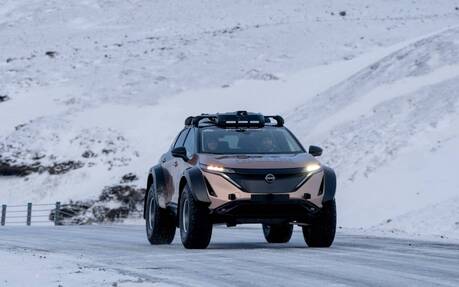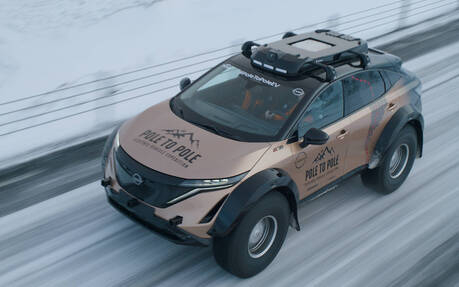Nissan Unveils Beefed-up Ariya for Pole-to-Pole EV Expedition
Nissan, which last year announced plans to undertake a 27,000km trip from the magnetic North Pole to the South Pole in an electric vehicle, today unveiled the modified Ariya that will be used for this adventure.
Since the EV crossover will have to take on extreme terrains and environments including ice fields, deep snow, steep mountain climbs and inhospitable desert dunes, Nissan’s design and engineering teams have partnered with Arctic Trucks, a company that specializes in polar expedition vehicles.
- Also: Nissan Has Some Cool and Crazy Ideas for SEMA 2022
- Also: 2023 Nissan Ariya: Two Sides of Premium
The most obvious difference is the beefed-up suspension and 39-inch BF Goodrich all-terrain tires, the latter sitting below massively flared fenders. Up on the roof, a set of crossbars allowed Nissan to mount a utility platform with built-in off-road lights, a camera and even a drone that can be launched to take pictures.

Crucially, no modifications have been made to the 87kWh battery, the dual-motor powertrain (389 hp) or the e-4ORCE electric all-wheel drive system. After all, the idea is to test the Ariya’s power and range (estimated at 426 km in this configuration) as available to customers.
The drivers for this unique expedition are husband and wife Chris and Julie Ramsey, who previously became the first people to complete the gruelling 17,000km Mongol Rally in an electric vehicle, their own Nissan LEAF.
"One of the things that underpins all the adventures we do is that we take a standard production EV and aim to make minimal changes to clearly demonstrate its real, everyday capabilities, regardless of where you are driving it,” Chris Ramsey said. “I'm incredibly excited to get behind the wheel of what was already a brilliant vehicle, but now feels equipped to take on the ends of the earth in style!"

Since charging stations will be few and far between most of the time, including in the polar regions, a portable, renewable energy unit will be used to charge the Ariya. The towable prototype includes a packable, lightweight wind turbine and solar panels that will take advantage of high winds and long daylight hours to provide charge for the battery when the vehicle is stopped.
The 10-month-long Pole to Pole expedition will begin in March. You can follow the action in real time via this dedicated website Nissan has launched.
